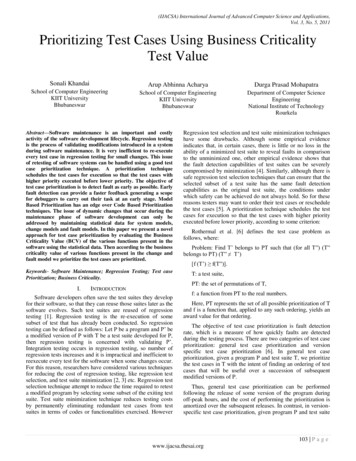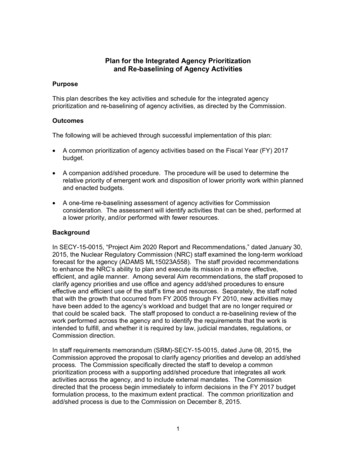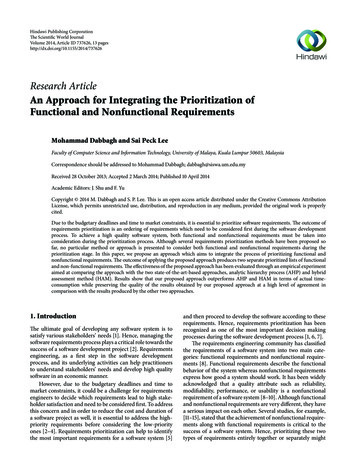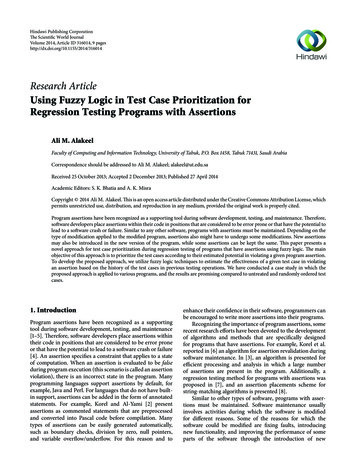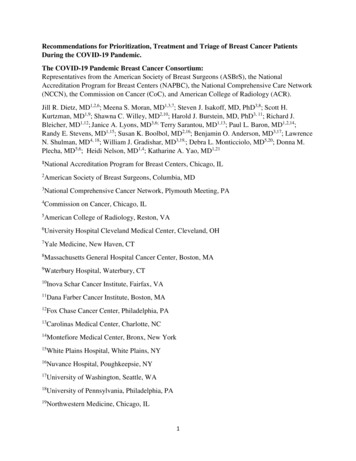
Transcription
Recommendations for Prioritization, Treatment and Triage of Breast Cancer PatientsDuring the COVID-19 Pandemic.The COVID-19 Pandemic Breast Cancer Consortium:Representatives from the American Society of Breast Surgeons (ASBrS), the NationalAccreditation Program for Breast Centers (NAPBC), the National Comprehensive Care Network(NCCN), the Commission on Cancer (CoC), and American College of Radiology (ACR).Jill R. Dietz, MD1,2,6; Meena S. Moran, MD1,3,7; Steven J. Isakoff, MD, PhD3,8; Scott H.Kurtzman, MD1,9; Shawna C. Willey, MD2,10; Harold J. Burstein, MD, PhD3, 11; Richard J.Bleicher, MD1,12; Janice A. Lyons, MD3,6; Terry Sarantou, MD1,13; Paul L. Baron, MD1,2,14;Randy E. Stevens, MD1,15; Susan K. Boolbol, MD2,16; Benjamin O. Anderson, MD3,17; LawrenceN. Shulman, MD4, 18; William J. Gradishar, MD3,19,; Debra L. Monticciolo, MD5,20; Donna M.Plecha, MD5,6; Heidi Nelson, MD1,4; Katharine A. Yao, MD1,211NationalAccreditation Program for Breast Centers, Chicago, IL2American Society of Breast Surgeons, Columbia, MD3National Comprehensive Cancer Network, Plymouth Meeting, PA4Commission on Cancer, Chicago, IL5American College of Radiology, Reston, VA6University Hospital Cleveland Medical Center, Cleveland, OH7Yale Medicine, New Haven, CT8Massachusetts General Hospital Cancer Center, Boston, MA9Waterbury Hospital, Waterbury, CT10Inova Schar Cancer Institute, Fairfax, VA11Dana Farber Cancer Institute, Boston, MA12Fox Chase Cancer Center, Philadelphia, PA13Carolinas Medical Center, Charlotte, NC14Montefiore Medical Center, Bronx, New York15White Plains Hospital, White Plains, NY16Nuvance Hospital, Poughkeepsie, NY17University of Washington, Seattle, WA18University of Pennsylvania, Philadelphia, PA19Northwestern Medicine, Chicago, IL1
20Baylor Scott & White Healthcare-Central Texas21NorthShore University HealthSystem, Evanston, ILCorresponding author:Jill R. Dietz, MD, FACSASBrS (President),NAPBC (Vice chair, Standards and Accreditation Committee)Associate Professor of Surgery, Case Western Reserve University School of MedicineDirector Breast Operations University Hospitals Seidman Cancer CenterCleveland, OhioJill.Dietz@UHhospitals.orgWord count: 2966 (without tables)Abstract word count: 239References: 572
STRUCTURED ABSTRACTThe COVID-19 pandemic presents clinicians a unique set of challenges in managingbreast cancer (BC) patients. As hospital resources and staff become more limited during theCOVID-19 pandemic, it becomes critically important to define which BC patients requiremore urgent care and which patients can wait for treatment until the pandemic is over. Inthis Special Communication, we use expert opinion of representatives from multiple cancercare organizations to categorize BC patients into priority levels (A, B, C) for urgency of careacross all specialties. Additionally, we provide treatment recommendations for each of thesepatient scenarios. Priority A patients have conditions that are immediately life threateningor symptomatic requiring urgent treatment. Priority B patients have conditions that do notrequire immediate treatment but should start treatment before the pandemic is over. PriorityC patients have conditions that can be safely deferred until the pandemic is over. Theimplementation of these recommendations for patient triage, which are based on the highestlevel available evidence, must be adapted to current availability of hospital resources andseverity of the COVID-19 pandemic in each region of the country. Additionally, the risk ofdisease progression and worse outcomes for patients need to be weighed against the risk ofpatient and staff exposure to SARS CoV-2 (virus associated with the COVID-19 pandemic).Physicians should use these recommendations to prioritize care for their BC patients andadapt treatment recommendations to the local context at their hospital.3
INTRODUCTIONThe COVID-19 pandemic poses unprecedented challenges for patients, clinicians andhealthcare systems. Across every facet of medicine, clinicians are responding to the pandemicby modifying patient care to minimize exposure risk and preserve resources, and themanagement of patients with cancer poses unique challenges.1 To provide preliminary guidanceon the prioritization and treatment of breast cancer (BC) during this severe acute respiratorysyndrome coronavirus 2 (SARS-CoV-2) outbreak, we assembled representatives from theAmerican Society of Breast Surgeons (ASBrS), the National Accreditation Program for BreastCenters (NAPBC), the National Comprehensive Care Network (NCCN), the Commission onCancer (CoC) and the American College of Radiology (ACR) to formulate an Expert Opinion.The objective of this Special Communication is to prioritize patient scenarios by urgency oftreatment by specialty and to make treatment recommendations based on these priorities withineach specialty. Given the rapidly evolving nature of the COVID-19 pandemic, time constraintsprohibited a formal consensus statement.These recommendations relate specifically to BC patients not suspected to have COVID19-related illness. We acknowledge that there are limited prospective experiences to guide theserecommendations. Furthermore, these recommendations are driven by the common goal topreserve hospital resources for virus-inflicted patients by deferring BC treatments withoutsignificantly compromising long-term outcomes for individual BC patients. The demands thatthe COVID-19 pandemic will place on healthcare institutions remain unpredictable and will havegeographical variability. Therefore, the risks of disease progression and compromised BCspecific outcomes need to be weighed against viral exposure to patients and staff, taking intoconsideration each individual’s comorbidities and age to predict risk of mortality from COVID-4
19. Lastly, these are recommendations and are not intended to supersede individual physicianjudgement or institutional policies and guidelines.METHODSAfter extensive multidisciplinary teleconference discussions and literature review, a“Priority” classification for BC patients was developed across the disciplines. Priority categorieswere defined based on the severity of an individual patient’s condition (including patient comorbidities) and potential efficacy of treatments.2Priority A Category:Priority A patients have a condition that is immediately life threatening, clinicallyunstable, or completely intolerable and for whom even a short delay would significantly alter thepatient’s prognosis. Assuming efficacious treatment, these patients are given top priority even ifresources become scarce, requiring urgent treatment for preservation of life or control ofprogressing disease or symptomatic relief.Priority B Category:Patients in the Priority B category are patients who do not have immediately lifethreatening conditions but for whom treatment or services should not be indefinitely delayeduntil the end of the pandemic. Most BC patients will fall under Priority B. If conditions in ageographic location only allow for Priority A patients to receive treatment, then treatment forPriority B patients can be delayed for a defined period of time during the pandemic. A shortdelay (e.g. 6-12 weeks) would not impact overall outcome for these patients. Longer delayscould impact outcomes in some Priority B patients and triage may become necessary to justify5
which patients should undergo treatment versus further delay. Patients within the Priority Bcategory will be sub-stratified as B1 (higher priority), B2 (mid-level priority) and B3 (lowerpriority) as defined by each BC subspecialty.Priority C Category:Patients in Priority C category are patients for whom certain treatment or services can beindefinitely deferred until the pandemic is over without adversely impacting outcomes.RESULTSPriority categories and treatment recommendations by specialty are listed below.Outpatient visitsDuring the pandemic, the majority of encounters should be conducted remotely viatelemedicine. Decisions to conduct in-person visits must carefully weigh the risk of viraltransmission to patients and healthcare providers with the need for an in-person evaluation.Priority A includes, for example, clinically unstable post-operative patients and those withpotential medical oncologic emergencies (e.g. febrile neutropenia, intractable pain) who need tobe assessed in-person. Priority B patients should be evaluated by at least one member of themultidisciplinary team in-person or remotely depending on need. These include: newlydiagnosed BC patients; established patients with new problems (breast infection, palpablefindings, and significant symptoms from therapy); patients on active IV chemotherapy; patientscompleting neoadjuvant therapy preparing for surgery; routine postoperative patients; andpatients being evaluated and planned for radiation therapy. Priority C patients are those6
presenting for routine follow up for benign or malignant conditions (including those on oraladjuvant agents and those not on active treatment), survivorship visits, or high-risk screening andcan be seen remotely or delayed until the post-pandemic period. Increased precautions should betaken surrounding in-person visits/treatments for patients with co-morbidities and a high risk ofCOVID-19 complications.Breast Focused ImagingFew scenarios are designated Priority A for breast imaging, with the exception ofimaging for urgent situations such as a severe breast abscess formation or for evaluation of aserious post-operative complication.Breast imaging Priority B includes diagnostic imaging for an abnormal mammogram orfor suspicious breast symptoms, biopsies for BI-RADS 4 or 5 lesions, and breast MRI for extentof disease evaluation or pre-chemotherapy assessment. Biopsies for lower suspicion lesions (BIRADS 4a) may be postponed or biopsied. BIRADS category 3 patients returning for short-termfollow-up diagnostic mammogram and/or ultrasound and routine breast exam should bepostponed until the COVID-19 pandemic is over and would be Priority C. All screening examsincluding mammography, ultrasound, and MRI should be placed in Priority C and suspendeduntil the post-COVID-19 period. BRCA mutation carriers under the age of 40 may beconsidered for screening if delays of more than 6 months are expected.3,4Surgical OncologyTable 1. lists patient scenarios into Priority categories for urgency of surgical care. Theneed to minimize use of operating room resources requires selectively deferring surgery and7
triaging patients for use of an initial alternative therapy whenever possible. However, level IIevidence demonstrates that preoperative delays may impact BC outcomes.5,6Invasive BC patients should be triaged with multidisciplinary input and assessment ofpatient’s risks and co-morbidities to potentially receive neoadjuvant therapies during thepandemic. While neoadjuvant chemotherapy confers risks of immunosuppression and usespersonal protective equipment (PPE), high risk breast cancers would fall in Priority B becauseupfront surgery is not required when systemic treatment is initiated. Current standards for triplenegative breast cancer (TNBC) and human epidermal growth factor 2-overexpressing (HER2 )BC already include neoadjuvant therapy, which has very high rates of clinical and pathologicaltumor response affording durable tumor control prior to deferred surgery.7,8Patients completing neoadjuvant chemotherapy are categorized as Priority B1. Delays ofsurgery up to 8 weeks post-chemotherapy do not adversely affect BC outcomes.9 Breast imagingcannot be used as a surrogate to assess pathologic response because false negative rates varybetween 17.8 and 50%.10-13 In the event that resources do not allow for surgery, additional nonsurgical therapy should be considered (see Medical Oncology section).Patients with hormone receptor-positive BC are Priority B3 or C because neoadjuvantendocrine therapy allows for deferment of definitive surgery. Studies evaluating tamoxifenwith/without surgery demonstrate no difference in survival within the first three years suggestingthat short-term deferment of surgery with endocrine therapy should not adversely impact BCspecific survival.14-16Patients eligible for breast conservation should be discouraged from elective mastectomydepending on local institutional resources. For patients requiring mastectomy, immediate8
reconstruction with implant or tissue expanders can be performed only if hospital resourcespermit. Autologous reconstruction should be deferred.17Discordant biopsies are uncommon, but when they occur, establishing the presence ofmalignancy is required.18 These patients would be categorized in Priority B or C depending onlevel of suspicion.For newly-diagnosed, recurrent BC, staging evaluation is preferred but may beunavailable. Surgery is typically indicated only in the absence of metastatic disease. Treatmentwill depend on resource availability (see Medical Oncology section).Re-operation for margins or axillary staging is Priority C when there is a low likelihoodof residual disease.19 Patients with estrogen receptor positive (ER ) ductal carcinoma in situ(DCIS) and low volume ER- DCIS are Priority C1 whereas patients at high-risk for occultinvasion are Priority B3. Non-operative trials however, are limited to low-risk DCIS.20-22Practitioners caring for BC see many benign conditions. If a malignant lesion isunlikely, diagnostic procedures should be postponed. It is advisable to follow-up with patientswhose treatment is being altered or postponed. The enormity of changes from the COVID-19pandemic itself are anxiety-provoking among patients and practitioners. Patient psychologicalwell-being needs to be considered and often can be addressed with telemedicine/phone visits.While shared decision-making is ideal, in the context of the pandemic difficult choices must bemade.Medical Oncology9
Table 2 lists patient scenarios into Priority categories for urgency of either hormonal,chemotherapy and/or targeted therapy. The medical oncology goals are to minimize patientinteractions with healthcare centers, maintain patient safety, and conserve resources whileproviding effective care. All specialty and institutional goals and patient factors should beconsidered when formulating a treatment plan. Priority A patients are those with oncologicemergencies requiring immediate treatment (e.g. febrile neutropenia, intractable pain). Priority Bpatients require systemic care but are candidates for modified therapeutic approaches to achievethe goals above; the urgency and therapeutic options are stratified into higher-to-lower priorities(B1-B3). Priority C patients can delay interventions for many months without adverse impact onsurvival or quality of life.Invasive BC – Early StageFor newly-diagnosed BC patients, multidisciplinary plans can be revised to protectpatients and spare healthcare services (Priority B). Depending on local circumstances, surgery,systemic therapy, and radiation therapy (RT) sequencing may be altered to ensure patient safetyand healthcare system needs. Neoadjuvant treatment is well established for all BC subtypes andenables delayed surgery. If necessary, RT can be given before adjuvant chemotherapy (especiallyfor ER tumors) without affecting long term outcomes.23Patients with ER , HER2- tumors can defer surgery and receive neoadjuvant endocrinetherapy for 6 to 12 months without clinical compromise (Priority B1). 24,25 Patients should beassessed periodically to confirm absence of tumor progression. Patients with Stage 1 or limitedStage 2 disease (including those with N1 nodal involvement), and those with low-intermediategrade tumors, lobular BCs, low-risk genomic assays (especially the recurrence score, which maybe sent from a core biopsy26), or “luminal A” signatures, do not benefit substantially from10
neoadjuvant or adjuvant chemotherapy 27,28. These patients may receive endocrine therapyalone.TNBC patients should receive standard chemotherapy approaches (Priority B1), and allBC subtypes currently receiving neoadjuvant or adjuvant treatment should complete standardregimens already underway. Abbreviated schedules or dose modified regimens may beconsidered. Single-agent sequential therapy may reduce treatment complications withoutcompromising efficacy.29Patients with Stage 1 or 2, HER2 BCs may consider ado-trastuzumab emtansine ( /pertuzumab) with comparable efficacy to chemotherapy/trastuzumab-based regimens in eitherneoadjuvant or adjuvant settings (Priority B2) to minimize neutropenia, visits, and steroiduse.30,31 Adjuvant trastuzumab-based therapy may be shortened from 12 to 6 months withoutaffecting outcomes in selected patients (Priority B3). 32,33Invasive BC – Advanced StagePatients with advanced (metastatic) BC have many treatment options and typicallyreceive multiple lines of therapy which are rarely dependent on specific treatment sequencing.Dose and schedule adjustments of systemic treatments are reasonable to reduce clinic visits,bloodwork, and development of significant side effects. Patients without signs or symptoms oftumor progression may defer routine restaging scans. When the likely benefit of additionalpalliative chemotherapy is very small, patients may find the risks of treatment outweigh thepossible gains in outcome.Trastuzumab, pertuzumab, and related antibody-drug conjugates for HER2 tumors maybe given at less frequent dosing intervals, as necessary. Patients with HER2 BC with 2 years11
duration of tumor control and minimal disease burden with trastuzumab-based regimens mayconsider interrupting maintenance therapy.34The use of oral targeted agents (CDK4/6, mTOR, and PIK3CA inhibitors) in ER ,metastatic BC must be weighed against the increased risk of adverse events. Dose reductionscan minimize treatment-related toxicities. CDK4/6 inhibitors as first/second-line treatment offerclinical advantage, but may be delayed if the likelihood of tumor control is high with endocrinetherapy alone (first line, no prior endocrine treatment, no visceral disease).35 Dose reduction ofpalbociclib does not diminish efficacy.36,37High Risk Lesions and Pre-Invasive BCHigh-risk lesions such as atypical hyperplasia and lobular carcinoma in-situ express ERand are effectively treated with either tamoxifen or aromatase inhibitors.38,39 ER DCIS can betreated with preoperative endocrine therapy for 6 months (Priority C).40 For management of ERdisease see Surgical Oncology section.Supportive care and additional considerationsEndocrine treatments (tamoxifen, aromatase inhibitors, luteinizing hormone releasinghormone (LHRH) agonist) are safe and can be continued thru the COVID-19 pandemic (Table3). LHRH agonists may be given every 3 months, and home administration is an option.41Patients receiving chemotherapy should receive appropriate supportive care to reduce sideeffects; in particular, granulocyte colony-stimulating factor (G-CSF) should be used to minimizeneutropenia, and can be considered for regimens with 20% chance of febrile neutropenia notusually offered G-CSF. Interventions that alleviate severe symptoms should remain a highpriority. Bone modifying treatments (intravenous bisphosphonates or denosumab) can be12
deferred in patients without hypercalcemia, on adjuvant therapy, or on long-standing courses oftherapy.Radiation OncologyRadiation therapy (RT) plays an integral role in the treatment of many BCs. Patientrelated factors (age, comorbidities) contributing to infection risk must be carefully weighedagainst the risk of worsened BC outcomes if delaying the anticipated local-regional and potentialsurvival benefits of RT. Priority A includes patients presenting with symptomatic disease inwhom short palliative RT regimens should be utilized.42-44 Patients clinically progressing onneoadjuvant therapy should be considered for a longer definitive pre-operative hypofractionated(HF) regimen to reduce risk of continued progression if surgically unresectable or resourceconstraints prohibit timely surgery.45,46The majority of RT referrals will likely be Priority B requiring triage/deferment. Limitedpublished data on RT delays in the definitive setting are inconsistent. Locally-advanced orinflammatory patients may have worse outcomes after neoadjuvant chemotherapy if RT isdelayed 8 weeks (Priority B1).47 In contrast, delaying RT 20 weeks in early-stage, ER patientsafter BCS demonstrates no difference in outcomes compared to 4-8 weeks (Priority B3).48 SincePriority B sub-stratifies by clinical-pathologic recurrence risk, B1 patients should be givenpriority over B2 or B3; hypofractionated (HF) regimens should be strongly considered wheneverpossible. Long-term outcomes with HF-RT utilizing 42.5Gy/16 or 40 Gy/15 fractionsdemonstrate safety and efficacy similar to conventional fractionation which will reducepatient/staff exposure.45,46 Though regional-nodal and post-mastectomy patients were underrepresented in these trials, historic49 and emerging50 data suggest no differences in efficacy ortoxicity for these sub-groups. Current trials are evaluating HF with reconstruction13
(Alliance221505/ NCT03414970; FABREC Trial/ NCT03422003). Furthermore, additionalintensive regimens after lumpectomy (FAST: 28.5 Gy in 5 once-weekly fractions51,52; FASTForward: 26 Gy in 5 fractions over 1 week53) suggest early toxicity comparable to 40 Gy/15fractions. These regimens may be considered in selected patients undergoing breast RT (withoutregional-nodal RT). Similarly, a boost should be reserved for patients with greatest absolutebenefit (e.g. positive margins, age 40).54Priority C patients are those in whom RT does not affect survival outcomes and includesall DCIS with exception of ER- DCIS with positive margins (Priority B3), if re-excision is notpossible. Patients 65-70 years with early-stage, node-negative, ER invasive disease shouldstart endocrine therapy after surgery, with RT safely omitted or deferred until the pandemic isover. 55,56 A mechanism should be in place to re-evaluate patients for whom standard RT therapyis deferred so that recurrences/disease progression can be detected and managed appropriately.DISCUSSIONThe three Priority levels we have defined reflect the urgency of treatment during thispandemic resulting in multidisciplinary management recommendations taking into account theburden of the COVID-19 pandemic on our health system.Hospital Factors to Consider in Prioritization of BC PatientsIt is critical for physicians to understand the rapidly changing local conditions andavailable resources as well as risks/benefits of various treatments for patients, staff and hospitalsystems. Evolving local conditions and resources will influence which Priority category receivestreatment. Factors to consider include supply and equipment inventory (ventilators, PPE) andavailability of intensive care and inpatient beds. Other factors would be the proportion ofhealthcare personnel infected with SARS CoV-2, and whether BC treatment will put healthcare14
workers at risk. Finally, the prevalence of regional community transmission will determinehospital capacity for outpatient care. These aforementioned factors will determine which BCpatients receive treatment during or after the pandemic resolves.Importance of the Multidisciplinary Approach to the BC PatientThe basic tenets of cancer care coordination should be followed as much as possibleduring the COVID-19 pandemic. Management of BC patients requires a highly integrated andmultidisciplinary approach. An intervention in one specialty will have a direct impact on anotherspecialty. For example, the American College of Surgeons issued a statement that electivesurgeries should be canceled.17 Fortunately, many BC patients do not need upfront surgicalresection because of neoadjuvant treatment options. However, deferring BC cases will initiallyincrease the medical oncologist workload and will result in a backlog of procedures when thepandemic resolves. For these reasons, multidisciplinary discussion documenting Prioritycategory for surgery and/or adjuvant treatments is necessary to ensure the best outcomes forpatients. If feasible, tumor board discussions should include both standard and COVID-19recommendations based on institution’s level of pandemic severity. Documentation of thesediscussions in the medical record is highly recommended.Future DirectionsThis information should be used to organize a process of structured decision-making forthe care of patients with breast disease during the COVID-19 pandemic. However, as thepandemic rapidly evolves, we are increasingly learning about viral transmission and its impacton the health system, thus, these recommendations will evolve over time with continued updates.This consortium will continue to adapt these recommendations to the current pandemic severityincluding future waves of the COVID-19 pandemic. It is our hope that these current15
recommendations will help clinicians provide the highest quality care for their patients duringthis evolving pandemic.ACKNOWLEDGMENTThere was no funding source.16
REFERENCES1.2.3.4.5.6.7.8.9.10.11.12.13.Ueda M, Martins R, Hendrie PC, et al. Managing Cancer Care During the COVID-19Pandemic: Agility and Collaboration Toward a Common Goal. Journal of the NationalComprehensive Cancer Network : JNCCN. 2020:1-4.Ontario Health. Pandemic Planning Clinical Guideline for Patients with Cancer. clinical-guideline final 2020-03-10.pdf. Accessed 23 March 2020.Armes JE, Egan AJ, Southey MC, et al. The histologic phenotypes of breast carcinomaoccurring before age 40 years in women with and without BRCA1 or BRCA2 germlinemutations: a population-based study. Cancer. 1998;83(11):2335-2345.Monticciolo DL, Newell MS, Moy L, Niell B, Monsees B, Sickles EA. Breast CancerScreening in Women at Higher-Than-Average Risk: Recommendations From the ACR.Journal of the American College of Radiology : JACR. 2018;15(3 Pt A):408-414.Bleicher RJ, Ruth K, Sigurdson ER, et al. Time to Surgery and Breast Cancer Survival inthe United States. JAMA Oncol. 2016;2(3):330-339.Ward WH, DeMora L, Handorf E, et al. Preoperative Delays in the Treatment of DCISand the Associated Incidence of Invasive Breast Cancer. Annals of surgical oncology.2020;27(2):386-396.Sikov WM, Berry DA, Perou CM, et al. Impact of the addition of carboplatin and/orbevacizumab to neoadjuvant once-per-week paclitaxel followed by dose-densedoxorubicin and cyclophosphamide on pathologic complete response rates in stage II toIII triple-negative breast cancer: CALGB 40603 (Alliance). J Clin Oncol. 2015;33(1):1321.von Minckwitz G, Huang CS, Mano MS, et al. Trastuzumab Emtansine for ResidualInvasive HER2-Positive Breast Cancer. N Engl J Med. 2019;380(7):617-628.Sanford RA, Lei X, Barcenas CH, et al. Impact of Time from Completion of NeoadjuvantChemotherapy to Surgery on Survival Outcomes in Breast Cancer Patients. Annals ofsurgical oncology. 2016;23(5):1515-1521.Basik M, Cecchini RS, Santos JFDL, et al. Abstract GS5-05: Primary analysis of NRGBR005, a phase II trial assessing accuracy of tumor bed biopsies in predicting pathologiccomplete response (pCR) in patients with clinical/radiological complete response afterneoadjuvant chemotherapy (NCT) to explore the feasibility of breast-conservingtreatment without surgery. Cancer Research. 2020;80(4 Supplement):GS5-05-GS05-05.Heil J, Pfob A, Sinn H-PP, et al. Abstract GS5-03: Diagnosing residual disease andpathologic complete response after neoadjuvant chemotherapy in breast cancer patientsby image-guided vacuum-assisted breast biopsy: Results of a prospective multicentertrial. Cancer Research. 2020;80(4 Supplement):GS5-03-GS05-03.Peeters M-JTFDV, van Loevezijn A, van der Noordaa ME, et al. Abstract GS5-06:Towards omitting breast surgery in patients with a pathologic complete response afterneoadjuvant systemic treatment: interim analysis of the MICRA trial (Minimally InvasiveComplete Response Assessment). Cancer Research. 2020;80(4 Supplement):GS5-06GS05-06.Tasoulis MK, Lee H-B, Yang W, et al. Abstract GS5-04: Accuracy of post-neoadjuvantchemotherapy image-guided breast biopsy to predict the presence of residual cancer: A17
-institutional pooled analysis. Cancer Research. 2020;80(4 Supplement):GS5-04GS05-04.Fennessy M, Bates T, MacRae K, Riley D, Houghton J, Baum M. Late follow-up of arandomized trial of surgery plus tamoxifen versus tamoxifen alone in women aged over70 years with operable breast cancer. Br J Surg. 2004;91(6):699-704.Mustacchi G, Ceccherini R, Milani S, et al. Tamoxifen alone versus adjuvant tamoxifenfor operable breast cancer of the elderly: long-term results of the phase III randomizedcontrolled multicenter GRETA trial. Ann Oncol. 2003;14(3):414-420.Mustacchi G, Milani S, Pluchinotta A, De Matteis A, Rubagotti A, Perrota A. Tamoxifenor surgery plus tamoxifen as primary treatment for elderly patients with operable breastcancer: The G.R.E.T.A. Trial. Group for Research on Endocrine Therapy in the Elderly.Anticancer Res. 1994;14(5B):2197-2200.American College of Surgeons. COVID-19 Guidelines for Triage of Breast CancerPatients. ective-case/breast-cancer.Published 2020. Accessed March 29, 2020.Bluemke DA, Gatsonis CA, Chen MH, et al. Magnetic resonance imaging of the breastprior to biopsy. JAMA. 2004;292(22):2735-2742.Findlay-Shirras LJ, Outbih O, Muzyka CN, Galloway K, Hebbard PC, Nashed M.Predictors of Residual Disease After Breast Conservation Surgery. Annals of surgicaloncology. 2018;25(7):1936-1942.Elshof LE, Tryfonidis K, Slaets L, et al. Feasibility of a prospective, randomised, openlabel, international multicentre, phase III, non-inferiority trial to assess the safety ofactive surveillance for low risk ductal carcinoma in situ - The L
The COVID-19 Pandemic Breast Cancer Consortium: Representatives from the American Society of Breast Surgeons (ASBrS), the National . (ASBrS), the National Accreditation Program for Breast Centers (NAPBC), the National Comprehensive Care Network (NCCN), the Commission on Cancer (CoC) and the American College of Radiology (ACR) to formulate an .

